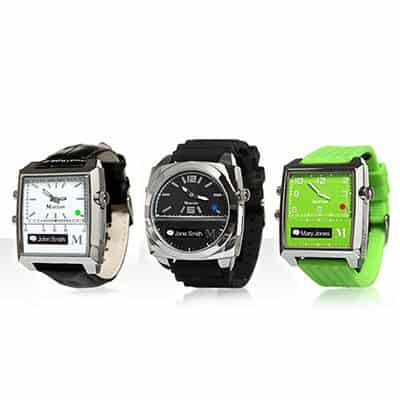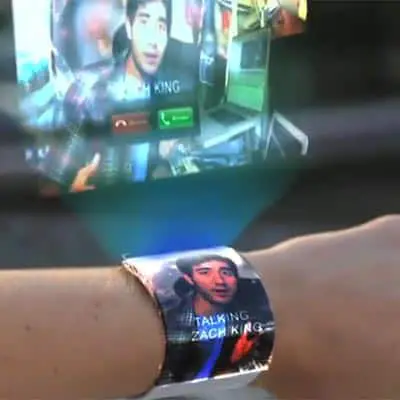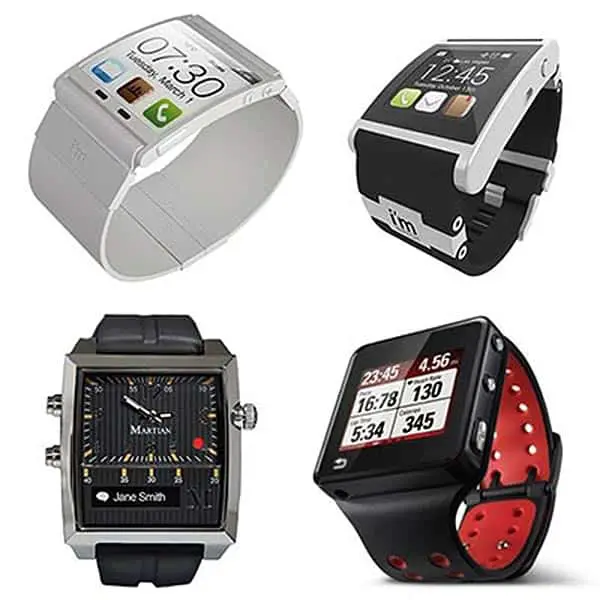Rarely is a new technology released to the public that defies categorization. As computers, laptops, touchscreen tablets, and smartphones have slowly melded into a single industry of personalized tech gadgets, now comes a new curious item to add to this growing list: the smartwatch. For decades, a number of interesting technologies have been thrust upon the common wristwatch, but relatively few have been received with any amount of overwhelming success. As we push into 2013, dozens of companies are scrambling to place an advanced new product into the emerging smartwatch market … a market that is sure to explode in the coming months.
It is tough to define this type of technology, but most of the primary competitors seem to have a few similar features. First, the item is obviously worn on the wrist and generically displays time, but the features from that point have shot off in a variety of directions. Traditional wrist watches that added “smart” features generally carried out only the most basic tasks: fundamental arithmetic or calendar functions. Outside of these remedial abilities, smartwatch technology has contributed little to making one more productive or adding convenience. Accordingly, smart watches have not yet made their way into the quivers of mainstream technology aficionados.
Newer features finding their way into recent smart watches include GPS functions and a biometric feedback. By including a GPS tracker in the watch, everyone from running enthusiasts to outdoor adventurers can rely on this basic technology to track their movement and find their way home. The biometric sensors, generally attached to a heart rate monitor or similar device, allow users to keep a close eye on how much they are exerting themselves while running, biking, swimming or carrying out any other physical activity. Howver, one of the newest and most exciting additions to smartwatch technology is the level of connectivity that the customer will have on a device that is readily visible and accessible. From 3G and 4G connections to Wifi and Bluetooth integration, one of the defining changes is coming in the form of more advanced options for sending and receiving data.

One of the most popular companies to delve headfirst into this emerging market is Pebble, a business that was Kickstarter funded and is skippered by Eric Migicovsky. The Pebble E-Paper Watch is exceptionally simple in its use and primarily functions as an accessory to your smartphone. Without a smartphone and a Bluetooth connection, the Pebble smartwatch will do little more than display the time. However, when connected to your smartphone, the watch will display new emails and other basic data that can be quickly skimmed through and deleted with a shake of the wrist. Some of Pebble’s main advantages over its competition are its weeklong battery life and the read-anywhere screen that has been popularized by eReaders.

Similar to the Pebble is the Martian smartwatch, another new business venture that relied on Kickstarter funding for its initial capital requirements. The Martian has more options for the user in addition to basic emails. With its Bluetooth connection, it can also display chat messages and even the local weather. Each of these products are ergonomic and efficient, but are not created to replace any existing technology.
The i’m Watch smartwatch is one step above the Pebble and Martion devices in terms of advertised features, but still requires a smartphone and Bluetooth connection. Along with receiving a number of notifications, the i’m Watch claims to provide users with some unique apps and a more refined and advanced color display. Users will be able to carry out some additional functions such as erasing emails, making calls, and skimming through their online calendar, all through touchscreen controls. However, the i’m Watch has received poor reviews due to its sluggish and buggy user interface.
Even with the relatively limited functionality of current smart watches, there has been huge interest in this emerging market with millions of dollars being feverishly invested in furthering the technology. Even companies such as Google and Microsoft are currently exploring how they can adapt their technology and incorporate it into the quickly evolving smartwatch niche.

Apple has recently indicated that it is develping its own vision of the smartwatch, with many expectedly coining this new product the Apple Watch. Apple’s anticipated move into the smartwatch market has many are wondering what features will be incorporated into upcoming devices and which of these features will be necessary to make them appealing to customers. That is good news for consumers as manufacturers scramble to enhance their existing technology, attempting to anticipate Apple’s likely epic offering. However, unfortunately for manufacturers, consumers aware of iWatch rumors are delaying smartwatch purchases, waiting for Apple’s “Next Big Thing.”
One large hurdle developers are facing right now is longevity of the smartwatch battery. Poor battery life is often a techno-gadget deal breaker and many companies will find themselves overlooked if they cannot compete with the new standard weeklong battery life boasted of by the most recent smartwatch manufacturers. Users will also want useful, but exceptionally basic features on their smartwatch. This means an easy-to-read display that can provide them with information on calls, emails, texts, the weather, and one’s calendar. However, the most fundamental issue facing smartwatch makers appears to be whether to design their products as a simple extension of the smartphone or to grant smart watches independence and design them to function primarily as stand-alone devices. This is by far the most interesting aspect of current smartwatch evolution and it will be interesting to see which way the market takes it.

